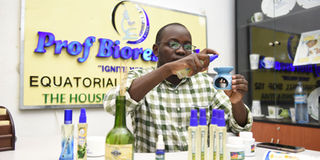When herbs become your source of income

Julius Nyanzi, a farmer and proprietor of Prof Bioresearch, explains how farmers can earn more from value addition. Photo by Ismael Kezaala
What you need to know:
- Value addition and produce processing are key aspects in reducing postharvest losses in the country and hence boosting its food security, writes Lominda Afedraru
Urban dwellers are gradually beginning to realise the importance of growing plants with medicinal value in their compounds.
Most of these plants include stevia rebaudiana for processing natural sugar, citronella grass for mosquito repellant, lemon grass and lemon eucalyptus for processing tea leaves.
These were some of the plants exhibited by scientists from Prof Bioresearch at the recently concluded Seeds of Gold Farm Clinic which took place at Makerere University Agricultural Research Institute, Kabanyolo (MUARIK).
Most farmers were flocking the tent where the plants were being exhibited not only to get knowledge about their use but many bought seedlings for planting.
The team at Prof Bioresearch has embarked on adding value to the plants in a bid to come up with medicinal products which are a remedy to particular health challenges faced by people.
Aaron Nyanzi, a farmer with Prof Bioresearch, explains that the initiative to add value to the plants is an idea of Julius Nyanzi who is the director of the company.
“I have been trained by Julius to process extracts from these plants and I also market the products. The most important thing is to grow the raw materials, which we are doing on one-acre land located in Masanafu but we also solicit material from
outgrowers who are located in the central and eastern regions, mainly in Busoga,” says Aaron Nyanzi.
During an interview with Moses Kibuuka, an ethnobotanist, he explains the procedure of how his team is adding value to these plants, thereby coming up with medicinal extracts which are already for sale.
How to extract sugar
Kibuuka notes that most people who have probably heard of steviol glycosides and stevia may wonder what the difference is.
Steviol glycoside is the extract from the stevia plant and it is what gives the leaves their sweet taste.
The path from leaf to sweetener is done in steps:
Collecting the dried leaves from the collection sites where smallholder farmers have deposited them.
Then the leaves are immersed in hot water and distilled using a solar energy distiller to extract the sweet taste from the leaves.
Filter to take away the fibres, salts and green colour using mechanical filters.
Undissolved parts are filtered in mechanical filters and dissolved salts and other ions are separated based on their molecular charge in large columns filled with charged particles, which attract the ions we want to remove from the extract liquid.
In the last step, processors choose a column with charged particles that attract the sweet molecules from the stevia leaf.
As the other solutes have run through this last column, food grade ethanol is poured over the steviol glycosides, which cause them to be released and mixed with the ethanol.
This process heightens the concentration of steviol glycosides as all impurities and contaminates that could affect the taste are removed.
Concentration
Most of the ethanol is recaptured in order to be reused at a later stage. This happens in a concentration step where the temperature is increased under low pressure to make ethanol evaporate.
The next step is to dry the concentrate to make crystals. The concentrated steviol glycoside and ethanol mixture is dried in a large tower.
The method is called spray drying and works by spraying the liquid into the tower at the same time warm, clean air is blown into the tower.
The liquid then dries quickly and crystallised steviol glycosides drop down to the bottom of the spray dryer, where it is collected.
In order to create different tasting stevia extracts a re-crystallisation is then used to change the concentration of the different steviol glycosides in the extract.
Re-crystallisation is a process where the stevia extract is dissolved in a mixture of water and food grade ethanol.
The mixture is then cooled down at which point the steviol glycoside found in the highest concentration will start to crystallise. By doing this a separation of different steviol glycosides can be obtained.
For liquid extracts, what is filtered is packaged in bottles of different sizes ready for sale.
Processing citronella
Citronella is a perennial clumping grass which grows to a height of five to six feet. It can be grown directly in the ground as well as in potted containers.
It is known to have originated from Thailand and gardening centres usually sell citronella as small plants in pots, ready to transplant and once its roots are established, new plants can be propagated from the parent plant.
While lemon grass is used as spice in tea, citronella is used as mosquito repellant and it is the major reason experts add value to it through processing into liquid and oil substance.
Kibuuka and his team process the grass to come with concentrates of liquid and oil. This is done using a distiller machine which uses solar or hydroelectricity energy.
The leaves are cut and sliced into pieces; it is compacted in the distiller and boiled. What is important to note is to ensure the heat supply is constant. It is then filtered and the extract is packaged in bottles.
Consumers are required to spray it on mosquito nets or curtain and the smell can last for one week.
It kills bedbugs and dairy farmers can use it to control ticks. What is needed is simply immerse the leaves in water and sprinkle animals with the water; the smell will repel ticks from animals.
Lemon eucalyptus
This eucalyptus species has a natural aroma which acts as tea spice. It is processed just like how ordinary tea leaves are processed from the plant. The team removes the eucalyptus leaves which is fermented for a required period, dried and packaged into tea leaves.
Marketing
The team packages stevia liquid at Equatorial Mall in 30ml which is sold at Shs5,000. The package in powder form consists of 180 grammes costing Shs15,000, 90 grammes sold at Shs7,500 and 45 grammes costing Shs3,000.
Consumers are required to put a drop in a cup of water and half spoon measurement for the case of the powder package. Citronella oil is packaged in 60ml bottle and 30ml costing Shs30,000 and Shs20,000 respectively. The seedlings for planting are sold at Shs5,000 per one seedling.
Town dwellers are encouraged to grow the seedlings in their compounds to repel mosquitos.
Stevia plant
Kibuuka explains that stevia is a natural sweetener, derived from the stevia rebaudiana plant that was first discovered centuries ago in Asian countries and later in America. In Uganda people from Kasese know it to have grown as a wild plant from time memorial. The plant is of different species but containing high sugar content. Stevia extract is available in many forms. The most popular is white extract powder, but you can also buy dried stevia leaves, stevia liquid extract or as small pellets to sweeten tea. The sweet leaf sweetener can as well be placed in tea to make it sweet.
It regulates hypertension; it is good for diabetic patients and has no calories. Farmers can plant it using cuttings which are potted and raised in nursery beds and transplanting can be done in three weeks from potting the seedlings. When seedlings reach around five inches tall, trim one to two inches off the main shoot to promote branching.
The farmer is an Organic researcher, you can reach him on +256702061652 or +256779519652.




